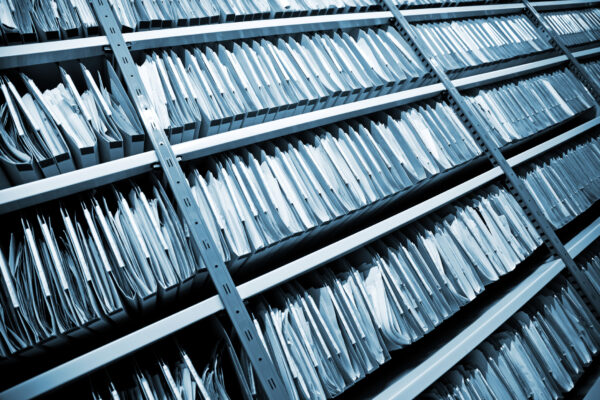When you work with a scanning partner to digitize your hard copy documents, you’re choosing them to take care of the work for you. But there’s an aspect that you may not have thought about–what if you need to access those documents during the project, when they’re not with you anymore?
Over many years and many projects, we’ve refined how we work with our clients to ensure they have access to their critical data even while we’re working on a scanning project for them. The BMI Request System is our answer to fulfilling record requests when you need the data but don’t have the physical records in front of you.
What Is BRS?
BRS is the acronym for our BMI Request System, and it’s an internal tool that we use to process client requests during projects. This ensures that our clients receive their files whenever they need them, even when they don’t have physical access to the records.
In practical terms, this situation arises when we’re working on a project and the documents are housed in our facility. Given that our clients don’t have access to the records directly, they rely on us to provide the necessary data and process their requests.
Evolution Of BRS
A request system wasn’t always based around BRS. In the past, we would execute client requests for their records using traditional methods such as phone calls and emails. This approach meant we kept track of the requests through manual processes like tracking individual email threads, taking notes, or using spreadsheets. Since it was a very manual process, it presented obstacles, particularly when dealing with a significant number of requests. On busy days or weeks when there were multiple clients with many requests, some could get overlooked or delayed due to tracking difficulties.

We even had a specific client sending us potentially dozens of requests daily, which we needed to fulfill. To address this daunting task, our software team collaborated with our production staff—the individuals responsible for record request fulfillment—and created an internal tool designed to streamline the entire process. This innovative tool became BRS.
The development and testing of BRS started internally to iron out the kinks. Once we were confident in its operation, we rolled it out to a small selection of clients for further testing and to gather feedback from their experience. After a successful trial period, we initiated a full-scale rollout and integration with our team, ensuring BRS would be utilized for all clients and request procedures moving forward.
How It Works
BRS is a simple tool to use. The way it works is that you log in using a username and password and then from there, you can enter a new request. Once you enter that request, BRS initiates a workflow and notifies our team that a new request is pending. The BRS team then locates the records that were part of the request, processes those records, and then uploads them to the application so you can access the records immediately.
Alternatively, the records may be uploaded to a different application, such as our Digital ReeL platform. Depending on your project specifics, this will determine where that request is fulfilled.

A standard turnaround for records requests is 48 hours (two business days). This means that if you request on a Wednesday, you’ll have access to your documents by Friday. If your request is on a Friday, then the records may not be available until the following Tuesday. However, we have various clients that operate on tighter or extended timelines. We can adjust our process to accommodate these needs, based on your requirements for fulfilling requests that you receive from your clients and patrons.

A critical aspect of our BRS functioning effectively is the organization of your records in their physical format. If your documents aren’t well-organized, locating them might be difficult, time-consuming, or even impossible. Therefore, if you plan on making requests for a digitization project while we have your documents, be aware that if your records are well-organized and easy to identify, it will streamline the process and make those records easier to locate, identify, and then fulfill the requests. However, if they aren’t well-organized, it may be difficult or we may not be able to fulfill those requests because of the inability to locate the records.
Benefits Of A Request System
Years ago, it didn’t seem like we had that many requests from clients, but recently, many of our clients who are running projects with us need to access their records. These clients are from various industries and organizations. In the past, we would handle requests manually, a process that was laborious. But we didn’t have that many requests at that time. Nowadays, it seems like we’re getting numerous requests every day. Having a BRS system is essential for fulfilling them without bogging down our team or holding up your fulfillment requirements.
So, the benefits of a request system are that it is automated where possible. This reduces or removes the manual effort which can slow the process down and lead to human error.
Also, there’s the added benefit of increased visibility for both us, BMI, and you, the client. You receive real-time document status updates, with request IDs tied to every request that’s created. This provides more clarity about which document requests we are discussing. Furthermore, there’s an in-app messaging feature to keep the request communication contained in one format. So, it’s not necessarily scattered across emails, phone calls, and texts. These discussions are all within BRS, providing a single place where you can see that communication thread.

Lastly, having a request system eliminates the issue of not being able to access your records during your project. At the end of the day, it’s not about how cool the BRS system is, or how sleek its communication or the apps are. What truly matters is whether or not you can access your records when you need them, even when they’re not within your reach. That’s the fundamental aspect of this, and that’s why we developed BRS. We aim to assist you because we understand how essential it is to have your records available, and how it can feel like being stuck on an island when they aren’t. BRS was created to ensure that you can always access these essential records.
Next Steps
Reach out to us today! Click the “Get Your Quote” button below, fill out the form, and we’ll quickly reply to you to discuss your project.
Further Reading
4 Must-Ask Questions Before Digitizing Your Records
Before you start your digitization project, ask yourself these four questions to ensure you’re on the right path.
What Are The Benefits Of Record Scanning Services?
By embracing digitization, organizations can enhance the accessibility and organization of their records and also fortify their security measures and streamline compliance processes.
Is It Safe To Use Record Scanning Services?
Worried about the safety of your records when you hire a scanning service company? Learn about security considerations for your project and compliance standards that can help guide your decision.

